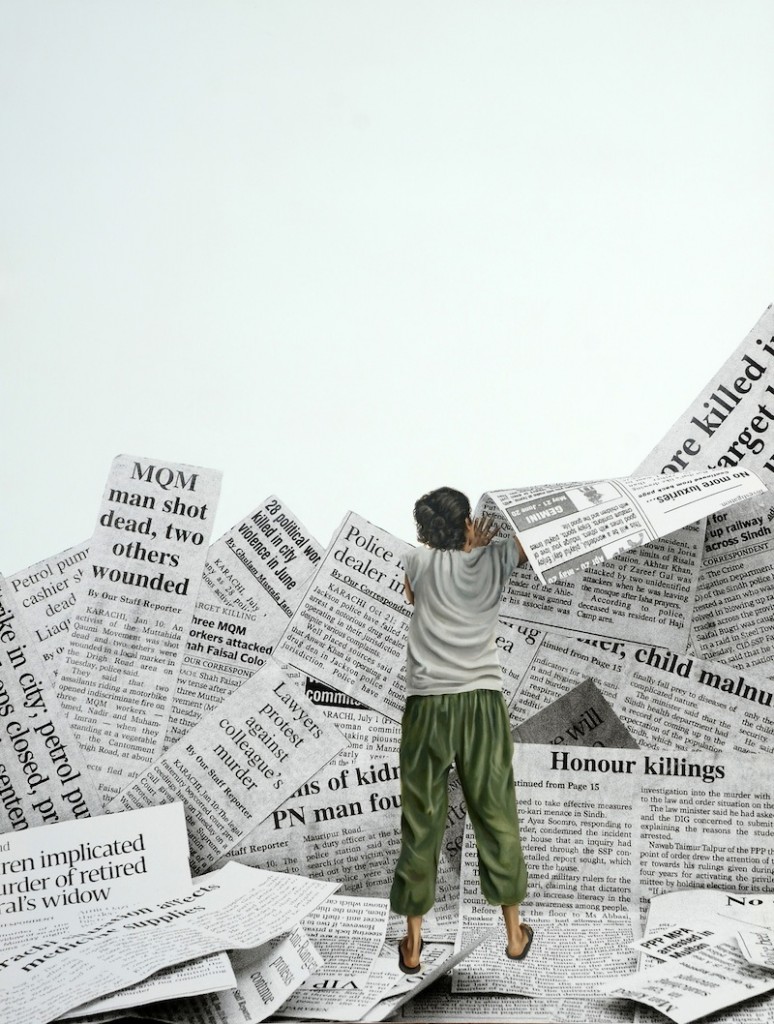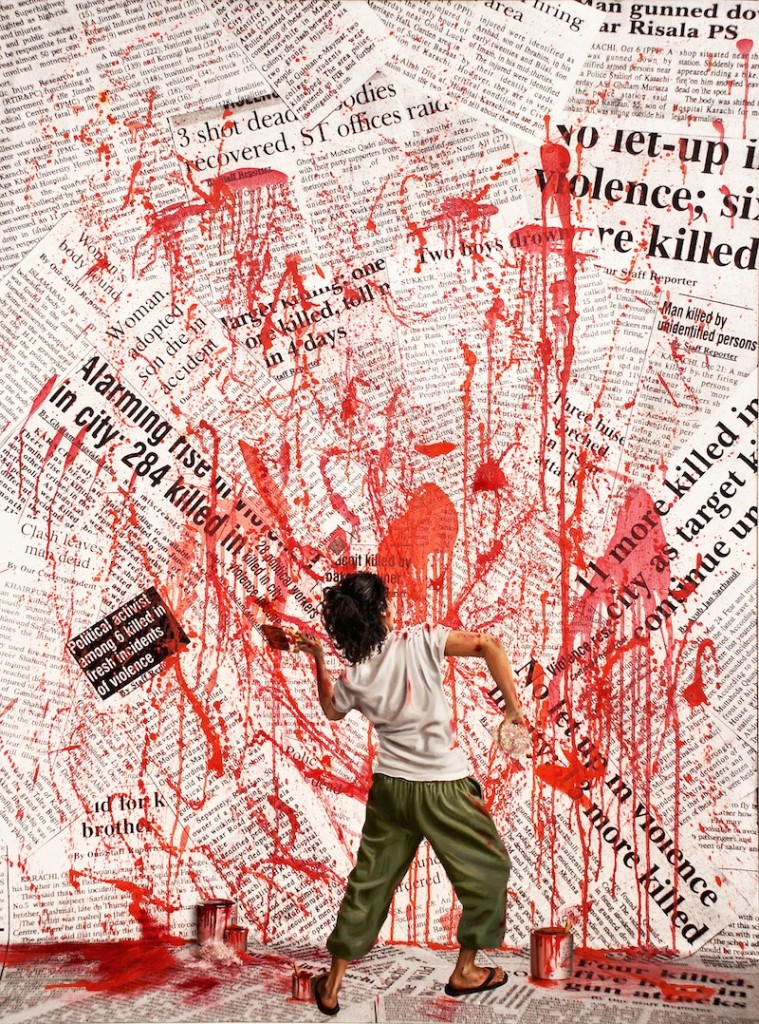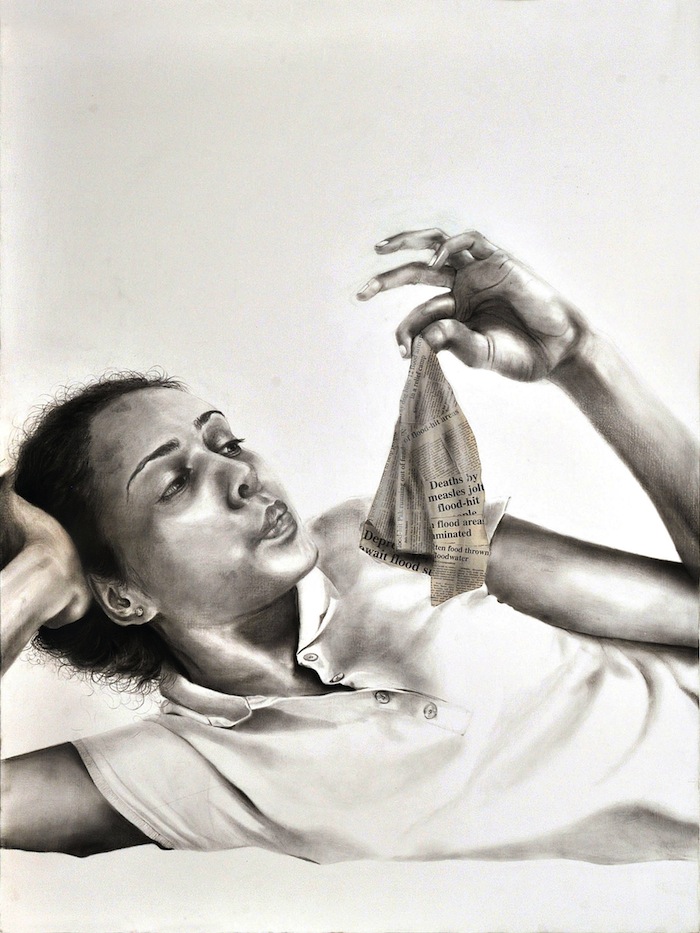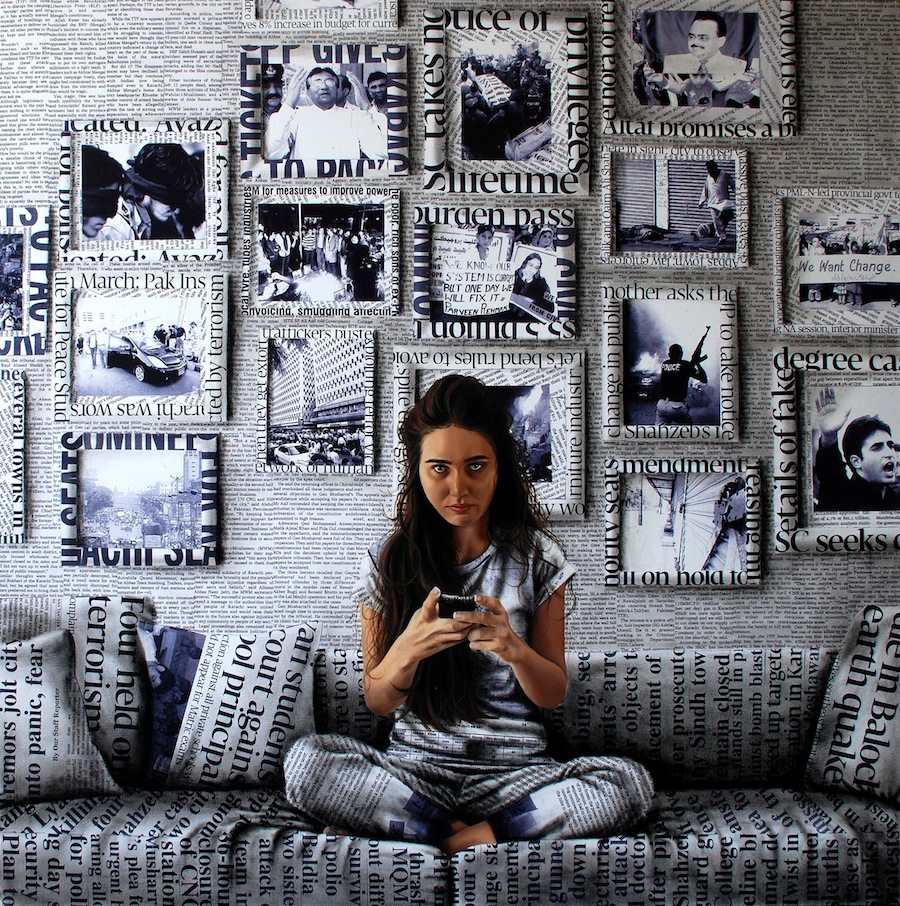Issue 9 Essay | Get the full digital print edition now! Subscribe | Purchase

Artist: Madiha Hyder, “Perfect Crime”| oil on digital print

Artist: Madiha Hyder, “Perfect Crime” | oil on digital print
“Now there is almost nowhere on the planet we are able to go to escape from it. It is there waiting for us in the early hours when we wake up from a disturbed sleep; it follows us on board planes making its way between continents; it is waiting to hijack our attention during children’s bedtime. The hum and rush of the news have seeped into our deepest selves.” – quoted by Madiha Hyder from Alain de Botton’s The News: A User’s Manual
The world of news encompasses an integral part of our lives. How we perceive a particular moment and most of all how we perceive ourselves in that moment is inextricably linked to, if not dictated by the media – with the newspaper being among the most common medium of consumption. In her series entitled “Mad World”, artist Madiha Hyder explores this link between the media and the construction of the self and the world.
Hyder channels the encompassing nature of the news to think about how a violence-ridden media engulfs and overshadows the lives of the inhabitants of Karachi through an overdo
se of information about the city’s grim events. Talking about the processes that have shaped her series in an interview with Tanqeed she says: “The newspaper has been a part of my morning ritual for the longest time. I had always been able to process the reportage with a certain degree of nonchalance, but then there came a point when the overload of distressing news started bothering me, stirring impulses of rage, despondency, fatigue, panic, ennui; eventually stimulating a yearning for escape. ‘Mad World’ was a result of all these emotions I was feeling.”
 Hyder graduated from the Indus Valley School of Art and Architecture in 2006where she today teaches art–conducting art workshops and continuing painting. Her installation is reactive, a response to the socio-political reality of Karachi. Her anxieties about the city she grew up in, the place that she calls home is embedded in the deepest layers of the canvas she paints. It is her receptiveness to news-casting and the violence it speaks of that transforms her paintings into a hard-hitting exhibit, where she not only offers a political commentary on Karachi, but also a personalized depiction of herself as both consumer and victim of an urban culture of violence and terrorism.
Hyder graduated from the Indus Valley School of Art and Architecture in 2006where she today teaches art–conducting art workshops and continuing painting. Her installation is reactive, a response to the socio-political reality of Karachi. Her anxieties about the city she grew up in, the place that she calls home is embedded in the deepest layers of the canvas she paints. It is her receptiveness to news-casting and the violence it speaks of that transforms her paintings into a hard-hitting exhibit, where she not only offers a political commentary on Karachi, but also a personalized depiction of herself as both consumer and victim of an urban culture of violence and terrorism.
“Mad World” was first exhibited in Karachi’s Poppy Seed Art Gallery and was a huge public success. It was the first time Hyder had used newspaper text in a digital form. Since then she has experimented with this technique in her other series: “Perfect Crime” and “Look At Me, Looking At You”. Both series reflect the evolving nature of the theme of violence in her art. The notion of madness taken from “Mad World”, however remains constant, becoming a metaphor for a “social order gone awry.”
“Perfect Crime-Prepare” to “Perfect Crime-Execute”
In a painting titled “Perfect Crime-Prepare”, Hyder invites the viewer to gaze upon a background that resembles a wall half-covered by digitized newspaper cuttings with headlines of the everyday violence and crime in the city of Karachi. On top of this surface there is an oil-painted figure of a girl pasting newspaper pieces onto the wall as if they were posters. Looking at the canvas, one’s eye is immediately drawn towards the sprawling bold captions and what they reveal?“MQM man shot dead, two others wounded”. “Honor killings”. “Lawyers protest against colleague’s murder”. “Petrol Pump cashier shot dead in Liaqatabad”. And so on. Stories of incidents on who was kidnapped, who was shot, and who was murdered.
In the next painting, the same image is transformed into a shocking depiction of a girl in an act of vandalism, splashing the now, fully-enveloped wall of haphazardly arranged newspaper captions with a bucket of red paint. The red color trickles down the wall making it look more horrifying than the content it addresses. Hyder names this piece,“Perfect Crime-Execute.”
——————————————————————————————————————————
Support independent media. Support Tanqeed.
———————————————————————————————————————————
Whether the painting represents an outpour of the artist’s frustration or whether it is a sign of active protestit is up to the viewer to decide. The message, however, is very clear:With her deft strokes of red paint, Hyder responds to the madness and violence that she experiences in her city, and tells her story of how it effects her world.The red blotches of paint are not striking simply because they appear on a black and white surface, but because red is a visual metaphor for blood. It is her way of showing that her city bleeds.
“Images of acts of destruction and reports of impending doom overwhelm me daily but as an artist I process the overload of information through acts of subversion, or rather simulated acts of subversion. I find myself drawn to surreptitious, nefarious thoughts of cutting, mutilating, vandalizing and defacing in order to strike back and speak out. My representation of subversive action thus becomes my safety valve, my device for release,” says Hyder.
Certainly, “Perfect Crime” is bold and aggressive in nature. There is an obvious claim of resistance. It is also more in the vein of documentation whereas the initial “Mad World” paintings deal with the artist’s own emotions. This is not to say that “Mad World” is not forceful; here, in fact, the madness outside is internalized.
The banality of violence
The fragments of newspapers that Hyder uses do not convey anything new. At a time and in a place where the narrative of violence is a familiar one, there is nothing immediately novel about the experience she portrays.We all see it unfold before our eyes, we hear about it, and we read about it in the newspapers. A suicide bomber explodes himself somewhere in the city and we hear the evening news reporting how many people died and live, and from the scene of the crime. We read about the funerals in the city in the morning newspaper, the very next day. A sense of sorrow and helplessness penetrates us, but then we simply turn the page, and move on. The repetitiveness of violence numbs us. So much so that the innumerable deaths in Karachi evoke no stir and no emotion.
For Hyder, tragedy is not something that happens to someone else. It is something that happens to us. It is something that happens to her too. That is why she finds it discomforting that we accept it as our fate.

Mad World. Graphite and charcoal powder, pencils, conte, newspaper clippings on canvas.
In a graphite and charcoal sketch that is part of her “Mad World” series, she has drawn a self-portrait, reclining, blowing a crumpled newspaper like a piece of used tissue paper. It is a portrayal of how by-the-way this culture of violence has become. It is as if it exudes a ‘presence-absence’ in our lives. Hyder is aware about the ordinariness of this news, but by magnifying it she suggests that it shouldnot be so ordinary, after all.
As an artist, she not only presents an aesthetic portrayal of what reality is from her point of view, she speaks to her audience from the vantage point of an observer, mediator, commentator and even provocateur. This dialectic relationship is what allows her art to transcend beyond the personal. She makes the viewer realize that what she paints is not just important to her; it is a matter of collective concern. She questions the banality of violence and makes us question it too.
Consuming violence
In “Pictures on My Wall” from her series “Look At Me, Looking At You”, Hyder complicates her work by depicting how the world of news and the violence in her city has invaded her private space. Even the picture frames on her wall carry images of the news about the gruesome events in the city. In a similar painting from “Mad World”, the viewer encounters her sitting in the centre of a circular arrangement of newspaper cuttings staring back with an expression that seems to ask “where do I go?” or perhaps, “is there another way I can think about my city?”
It is a question that forces her viewer to ask of themselves the very same question. Rather than showing actual images of violence, through an omnipresence of newspaper clippings in her work, she forces us to imagine the same. One is meant to read the newspaper captions as almost another act of reading about Karachi. In her series, the city is not only a visual component, but also textual construction. Each newspaper headline conjures an image that harrows us with fear. It turns into a spectacle before our eyes. We read about incidents that happened in the past, and are forced to confront our present situation only to realize that is no different. In fact, much worse.
“Mad World” is an introspective world where one is not just looking outward to the violence around and in the news, but also inward, into how that violence penetrates the self. Talking about the title, Hyder asserts: “We truly do live in a mad world! But there is also a personal implication; I am referred to as ‘Mads’ by those close to me, and since the work is a reflection of my emotions, I thought it perfect!”
To such an end, her series betrays a self-journey, in that she presents herself in the act of going mad. The strain upon her is evident as she portrays herself in moments of vulnerability, irritation, anger and even fear. In one painting the viewer looks at her tied up by newspapers in a fit of agony and despair. Her art is not just political but also psychological, as she herself remarks:
“For me, sources of news have taken on the role of informer, educator, protector, and paradoxically, destroyer of peace of mind.”
In “Mad World”, news and narrative are not two separate concepts but rather they become synonymous to one another. Hyder suggests that she is not outside of the news that tells her about the violence in her city. She is part of that news and it is her story. She is not just a recipient of a violence oriented news culture but also a psychological victim of it. In many ways then, in her series, the ongoing violence, comes to define the individual self as well.

“Mad World” bears testimony to the changes that have swept the contemporary art sphere, where in the wake of a rising trend in political art, artists have begun to address pertinent issues of their time, violence being a popular subject matter.
“Apart from the fact that violence has amplified ten-folds over the years in Karachi and we are being subjected to deal with it face-to-face on a daily basis, the media plays a significant role on the type of work being generated by artists today. The constant and ceaseless coverage of social, political, domestic and economic injustice on TV, newspapers and the internet have raised a greater awareness amongst people like never before,” says Hyder.
Her work falls in the locus of representational art. She emphasizes heavily on the form of the work itself. The subject matter of violence is filtered through her gaze. But, ultimately her emotions become representative of what everyone else is experiencing, which in turn expands the scope of her art as it speaks about the human condition in such turbulent times in Karachi.
What makes “Mad World” so appealing however is that it breaks away from an objective narrative of violence. The strength of her work comes not only from being unflinching in its stark portrayal of Karachi violence, but in attempting to comprehend it in a nuanced, realistic manner by putting herself in the centre of the narrative itself. The world that Hyder creates is deeply personal, a depiction of what she sees and what she reads about. It is a world she is concerned for and disturbed by at the same time. In the midst of the chaos that she is surrounded by, she seeks a moment of quietude in her art. She longs for peace but offers no solution. In fact, she questions her audience: “where is the end to this madness?” She gives us a reality check. She pokes us. She knocks at our conscience. She evokes our emotions. She makes us realize that we, too, are trapped in the same situation; we, too, are going mad inside of ourselves. We, too, cannot bear any longer this ongoing violence. Somewhere then, between admiring her artistic acumen and realism, one relates to her story in the city thinking about how it is not just her reality and her story, but also our own.
Saman Tariq Malik is a student at LUMS, pursuing a major in English with a minor in History.




a VERY VERY well written article. enjoyed reading especially part on ‘banality of violence’ was spot on!!
Great piece!!
A spectacular piece. The writer has really gone into the crux of Madiha Hyder’s art and whatever she writes makes so much sense. I am no artist but I am but I’ve seldom come across such an insightful review and such amazing work too
outstanding piece. Seldom one reads essay so insightful- the link between news, violence city and the artist as individual at the centre of it all.
Karachi on canvas — fascinating, via @TanqeedOrg, which everyone should be reading if they aren’t already. http://t.co/SkdpO2c7D2
A wonderful piece Saman!! Just saw this. I think what makes this unique is how you are able to analyse Madiha’s paintings in light of certain very powerful themes her work is embedded in. Was worth a read.
Fantastic piece by a fantastic writer. Feeling proud to be your friend. Keep inspiring readers across the globe with your unique insight into the world of act and the human condition!
Saman you excel in what you write. Loved reading it.
Saman this was mindblowing. EXCELLENT essay indeed and so well explained.
Thanks for sharing this Sana. As an artist i can really say that this is the first time i have come across a review that really does justice to an artist’s work. Thankyou Saman. This is a wonderful piece.
Well done Saman. This is a unique perspective on art that you have brought out and certainly a very serious issue in our times.
Read the previous article by this writer too. She is from LUMS. Impressed by her!!
Saman brilliant stuff. The last lines of your essay were hard-hitting i must say.
A much needed article. Well done
Saman does a marvellous job in ‘Karachi on Canvas’. Its true the art world is now shaped by an increasing concern over the political situation of the country. Some artworks take a direct stab atthe concept of violence while others like Madiha would reveal what it really means for individuals to live in a violent world- a world that seems to have gone mad.
OUTSTANDING ART REVIEW BY SAMAN. HIGHLY RECOMMENDED
Saman yaar this essay is beyond excellent. Someone also needs to take out time and see your own art paintings. Such talent in your own art as well. It’s your own insight into art plus your skill in literature and all that gives you an edge over what you have written about Madiha’ paintings. FEELING TREMENDOUSLY PROUD!
Saman amazing work. Love you and keep doing more of such write-ups because somehow you have a rarely found capacity of integrating different disciplines. MashAllah hai.
Saman this is a great piece. It is time people talk about this subject and whats better than reaching out through the power art
Saman im impressed by your ability to write. You are quite talented MashAllah.
Powerful essay
The writer has done a good job in showing through art how people experience the city space especially when it is makred by a high degree of violence. The subjectivity that art brings to an understanding of this theme is an area often overlooked.
This was truly worth read Saman. I love Madiha’s paintings and now with your essay you have made me her fan. The best lines that really made it so thought provoking: “She gives us a reality check. She pokes us. She knocks at our conscience. She evokes our emotions. She makes us realize that we, too, are trapped in the same situation; we, too, are going mad inside of ourselves. We, too, cannot bear any longer this ongoing violence. Somewhere then, between admiring her artistic acumen and realism, one relates to her story in the city thinking about how it is not just her reality and her story, but also our own.” SO TRUE
A very intense piece. Everyone should read it
Kamaal kar diya Saman. Zabardast
Woww man, good topic to write on. Saman’s a sweet acquaintance from LUMS who actually doesn’t know me as yet but she is quite famous for being both beautiful and brilliant.
good one. keep it up.
Way to go Saman. This was mindblowing. Feeling happy. To Tanqeed people: This is a suggestion that the very popular essays from your magazine issues should be brought up once again after their first publication on the facebook page to increase their readership. This article should certainly be one of them as it is the most popular one so far.
Just to pitch in my statement of appreciation: I think Saman’s essay is stupendously well written and she herself is the sweetest person I have ever come across.
I kind of found this topic interesting specially so because i am from Karachi and this violence has become a routine for all of us. Even i we are not direct victims of violence, we are victims to a discourse that shapes our very being, that creates an identity that goes international. To that end, i think this essay was a v. good attempt
Nice paintings Madiha
An awesome essay.
Impressive writing Saman. Look forward to reading more stuff!
Well written…
Fantastic article Saman. keep it up.
Very interesting Saman. people have found a good art reviewer i believe.
Good to see new work being projected by your magazine with an encouragement to new talented writers. Madiha’s paintings are surely good. But this article is stronger in picking up salient themes.
Great
Good job at this article. The reason its been so popular among art lovers is that Madiha’s paintings and this article have finally allowed for a discussion on how art is transcending its space to think of the new realism within art. So v.v.good
Wow Madiha you are so talented. Glad someone has portrayed this exactly. Best wishes!
Saman your writing is exceptional because you are able to pinpoint what the main issue and points are and then develop them in simple, fluent language. Good luck for your upcoming works in the future. May the force be with you always. Ameen.
Well everyone seems to have said pretty much what i wanted to say but still, knowing Saman as a dear friend from LUMS, a source of motivation, a guide, a tutor and someone who actually taught me how to write, I feel very proud and happy today at how famous her writeup has been. I feel happy because here is a person whose potential i could see when she used to speak in classes and when she was presenting her thoughts and when she was helping me with my work as well. Thank you to a great person. Thankyou to Saman.
this essay left me surprised. SAMMAANNN MANN YOU WRITE SO SO WELL. AND TANQEED PUBLISHED IT WOW DUDE, so happy for you
Madiha Hyder and Saman this is spectacular. An article shared by almost all art forums here as well as some popular art blogs is itself sign that there is something great. yes its worth reading and thinking
a fabulous essay by saman. heard about it on pakistan art review forum. Thankyou for this Tanqeed magazine
Thanks for not telling me you had done wonders on Tanqeed Saman! I found out from Ifra. I am prou an happy for you. This was a mindblowing essay, as excellent as your previous one on this magazine. I could make the relevant thematic links even when i dont know anything about art myself. This artist’s work is also beautiful. Hope to see more of your writing on Tanqeed in future.
Good work. its impressive samman
Well Written Saman…… This makesmuch sense given the times we live in.
Captivating article. Well done Tanqeed. Hope to see such work come along next time too. Keep up the good work
Good job to the author of this article. Really liked it
I think this article was markedly appreciated by large audiences in our country and abroad because firstly it was approaching the extremism in our country with a new perspective. Secondly, its not a journalist who is writing about this…the author is a student studying in LUMS who has written something that seems to come from the heart and of course not to mention she has a strong grip on expression even when that expression is simple. What journalists on the other hand do is sap away the personalized response that one might want to see coming through in article. Saman’s – the authors- strength lies in that part. She seems to have really understood what the artist madiha had perhaps wanted to show. Hence this was a job well tackled
The appreciation of this article and its writer is well deserved!
superb article saman. do you plan on writing more? you really should
yes saman have you produced a new masterpiece in this new issue. this article was a hit. love and best wishes to u
This was great Saman. Enjoyed reading. Its been a while now…hope to see you soon. miss you
Nice!
Oye!! NICE WOrK I came to her once to have my written stuff checked at uni. She helped me revise my piece a day before due and that placed me from C- student to B+. She is awesome person
saman is a lovely person. she’s intelligent and carries herself really very well.
very well expressed
saman this was beautiful
saman I think karachi on canvas took tanqeed to an almost new level. your ideas are unique. have u written anything else on this latest issue? I cant view. want to read more!!
eloquent writing deserves eloquent praise. listen to her in class. She has a strong lovely voice.
woah
Dear Madihah I was in Karachi when this artwork was exhibited. You work is as charming as it has been written about. I hope your future exhibitions capture the same popularity too 🙂 BEST OF LUCK. Rohan
Nicely explained. like her style
Hi, I just thought about saying a few profound things about the author. She is at the moment the most in demand research assistant and TA at LUMS university. She has graduated though- SIGH! And as far as my knowledge dictates she is also a winner of some thing highly precious during her moment. I don’t particularly know her because she acts tough when i try to speak but a really beautiful girl. I mean so tall smart and brilliant. And crazy chocolate brown eyes and black lashes